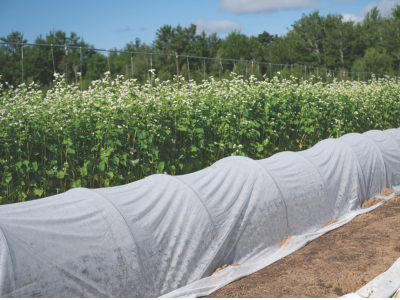- Artichokes
- Asparagus
- Baby Leaf
- Beans
- Beets
- Broccoli
- Brussels Sprouts
- Burdock
- Cabbage
- Carrots
- Cauliflower
- Celery & Celeriac
- Chicory
- Chinese Cabbage
- Collards
- Corn
- Cucumbers
- Eggplant
- Fennel
- Garlic
- Gourds
- Greens
- Horseradish
- Husk Cherry
- Kale
- Kalettes
- Kohlrabi
- Leeks
- Lettuce
- Melons
- Microgreens
- Mushrooms
- Okra
- Onions
- Parsnips
- Peas
- Peppers
- Potatoes
- Pumpkins
- Radishes
- Rutabagas
- Scorzonera & Salsify
- Shallots
- Shoots
- Spinach
- Sprouts
- Summer Squash
- Sweet Potatoes
- Swiss Chard
- Tomatillos
- Tomatoes
- Turnips
- Watermelons
- Winter Squash

Brassica Pests & Diseases
Although there are many insect pests and diseases of brassicas (aka crucifers), most can be prevented from damaging the crops by adhering to a few basic guidelines. In general, a preventative management approach involves a combination of the following practices:
- Proper crop rotation
- Only sowing disease-free seed
- Transplanting seedlings instead of direct-sowing
- Installing row covers as barriers
Read on for more information on employing these practices to reduce your pest and disease pressure.
What is Eating My Brassicas? Common Insect Pests of Brassicas
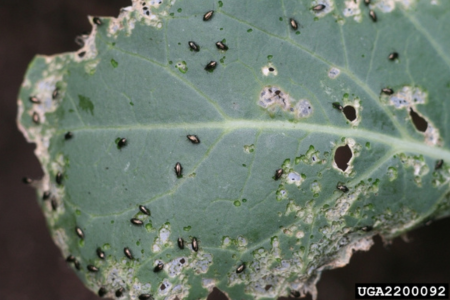
Flea beetle damage on brassica seedling.
Image courtesy Whitney Cranshaw, Colorado State University, Bugwood.org.
Flea beetles
Flea beetles will feed on brassicas at any stage of development but prefer the young, tender foliage of newly-germinated brassicas and tender transplants. If not controlled, they can quickly destroy seedlings and transplants. The telltale evidence of flea beetle feeding damage is a myriad of small pin-like holes in the leaves. There are two main species of flea beetles that are pests of brassicas: crucifer flea beetle (Phyllotreta cruciferae) and striped flea beetle (Phyllotreta striolata).
- For more info: U. of Mass., Amherst: Flea Beetle, Brassica
Cabbage "worms"
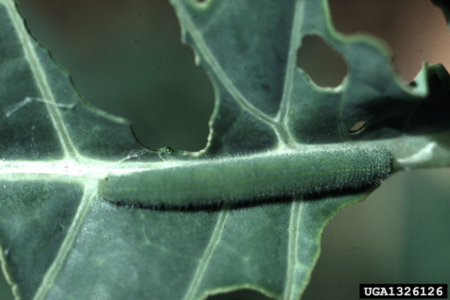
Imported cabbage worm (Pieris rapae (Linnaeus))
Image courtesy Whitney Cranshaw, Colorado State University, Bugwood.org.
Cabbage worms are the larval stage of cabbage moths and butterflies.
- Cabbage looper moth (Trichoplusia ni)
- Imported cabbageworm (Pieris rapae); aka small white butterfly
- Diamondback moth (Plutella xylostella); aka DBM or cabbage moth
All of these species feed on brassica leaves and, if they are present in large numbers, can cause severe leaf damage. Look for the bright green caterpillars. Be sure the check both sides of the leaves.
- For more info: U. of Mass., Amherst: Imported Cabbageworm
Aphids
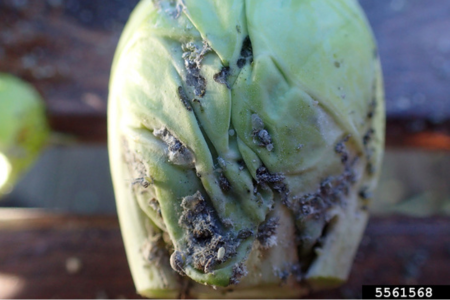
Cabbage aphid infestation of a Brussels sprout.
Image courtesy Whitney Cranshaw, Colorado State University, Bugwood.org.
Several species of aphids target members of the Brassicaceae. Aphids damage leaves and growing points by sucking sap from them, resulting in distorted and stunted leaves. They also excrete honeydew, which is a sugary waste product. Black sooty molds grow on the honeydew, creating a dirty, sticky mess.
Aphids can infest transplants growing in the greenhouse. Once the seedlings are transplanted to the field, the aphids can then multiply quickly. They are especially problematic if the transplants are grown under row cover because the row cover can protect the aphids from predators such as ladybugs and parasitic wasps. The temperatures are also usually a bit warmer under row covers, which results in aphids reproducing very quickly.
Severe infestations can result in partial or total crop loss.
Swede Midge
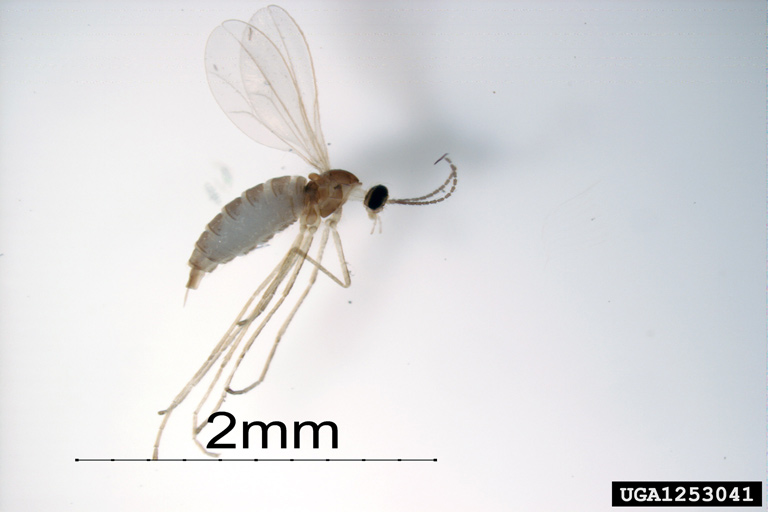
Swede Midge
Image courtesy Susan Ellis, USDA APHIS PPQ, Bugwood.org.
Swede Midge is native to Europe and southwestern Asia but has spread to the Northeast U.S. The larvae feed on the growing tips of brassicas, especially broccoli, cauliflower, collards, and kohlrabi. The damage causes malformed and misshapen plants and heads.
- For more info: U. of Mass., Amherst: Brassicas, Swede Midge
How can these pests be avoided?
Crop rotation. For growers/gardeners who practice proper (at least 3-year) crop rotations, insect pests of brassicas are less problematic. Farms should rotate fields and home gardeners should rotate garden rows/beds to ensure the 3-year rotation.
Transplants. Small seedlings of direct-seeded crops are most vulnerable to damage from pests—get a head start against pests by growing from transplants.
Row covers. Installing row covers is time well spent for protection against all of these insect pests. Row covers work by excluding insect pests; as such, you need to install them before the pest has found your crop. Immediately after direct seeding or transplanting in the ground, install row covers and seal the edges with pegs or soil so that pests cannot infest the crop. If you remove the row cover to weed, immediately re-install it.
We recommend Agribon+ AG-15 or ProtekNet for insect protection. You can float row cover over wire hoops or you can lay row cover directly on top of brassica crops. Usually, hoops are not needed. However, if you are growing in a very windy area, hoops can prevent high winds from whipping the row covers around and damaging the seedlings. We recommend keeping the crop covered until the plants are large enough to be pushing up against the row cover, the reason being that larger plants are less susceptible to insect damage.
- For more info on using row covers, see our article Protect Your Crops.
Weed control. To reduce potential feeding sites in the spring, control weeds around your planting, especially those in the brassica family, as they can be hosts for insects that can damage your crops.
Common Diseases of Brassicas
Several bacterial and fungal diseases are worth knowing about. You can gain a better understanding of the nature and root causes of common brassica diseases by referring to information provided by agricultural universities and extension agencies, as listed below. To learn more about crucifer diseases, we also recommend Cornell University Vegetable Disease Factsheets.
Bacterial Pathogens
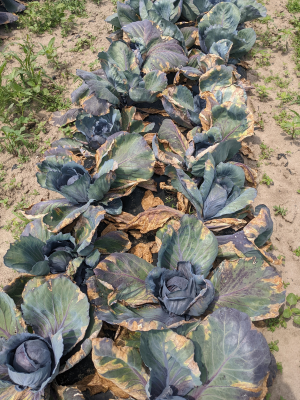
A row of cabbage severely affected by black rot.
Image courtesy of Dan Egel, Purdue University.
- Black rot of crucifers (Xanthomonas campestris pv. campestris)
The source of this pathogen is most often traced to infected seeds or transplants. Black rot can be identified by V-shaped yellow lesions on the leaves. In Brussels sprouts, tiny, immature sprouts often blacken and die on the stalk. This bacterial disease can destroy the crop and then persist in the soil for many years, so prevention is the best medicine.
Black rot can be avoided through crop rotation and using only seed lots that have tested negative for black rot. At Johnny's, we test all of our seed lots of broccoli, cabbage, cauliflower, collards, Brussels sprouts, kale, Kalettes, and kohlrabi and only sell black rot negative lots.
Growers can also choose to plant varieties with black rot resistance.
Fungal Pathogens
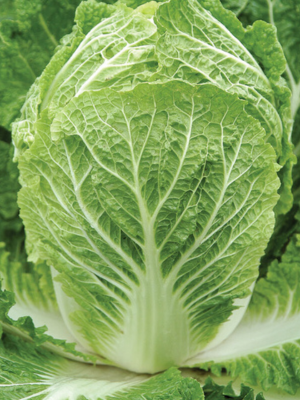
Some varieties offer resistance to fungal pathogens. For example, pictured above is 'Bilko', which offers club root and Fusarium yellows resistance.
Club root of crucifers (Plasmodiophora brassicae)
This disease causes the roots to become swollen and distorted, and limits water uptake. In addition to the root malformation, the leaves yellow and wilt. Its presence often goes undetected as the effect on the aboveground portion of the plant may not become apparent until water stress occurs. Infected plants will produce smaller yields or even die without producing a crop.
Like black rot, club root can persist in the soil for many years. This disease is best prevented through proper crop rotation.
Blackleg of cabbage and other crucifers (Phoma lingam; sexual stage Leptosphaeria maculans)
Fusarium yellows of cabbage and related crops (Fusarium oxysporum f. sp. conglutinans)
How can these diseases be avoided?
Practice proper rotation. If possible, only grow brassicas on the same ground every third or fourth year. These problems are mostly an issue in areas where crops have not been properly rotated. For specifics, contact your local cooperative extension agent.
Plant high-quality seed. Johnny's sells only seed lots that have tested negative for black rot.
If you have problems. Let us know, or see your crop advisor/cooperative extension agent.


